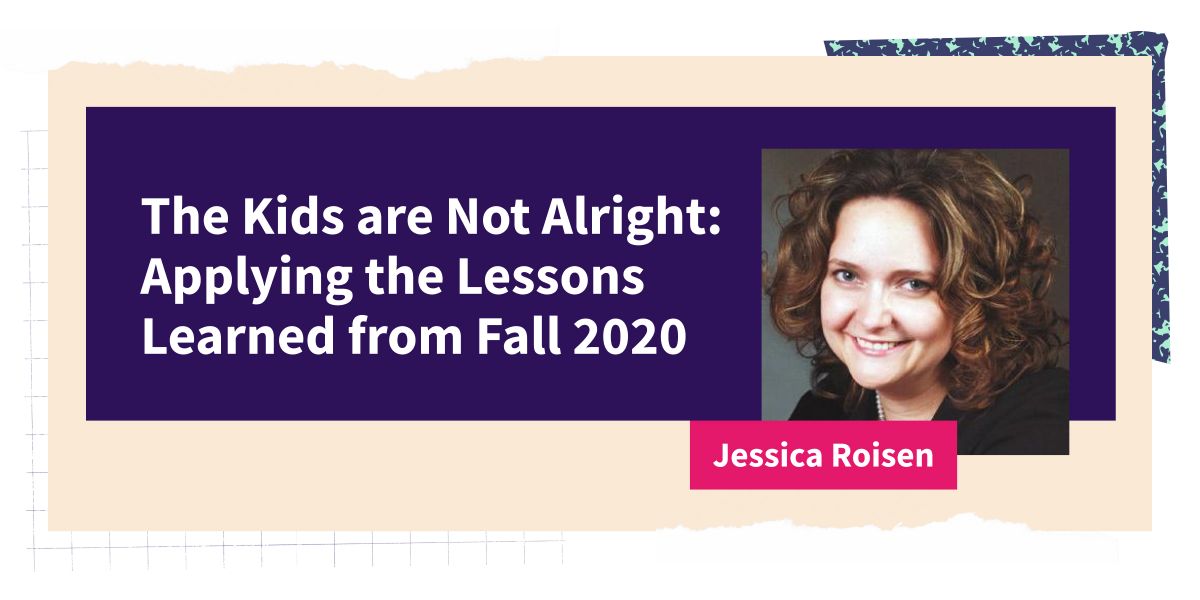Jessica Roisen is a Professor of Philosophy at St. Ambrose University. She is a certified mediator and health care ethics consultant, as well as Director of the St. Ambrose University Bioethics and Humanities Initiative. In addition to philosophy, Dr. Roisen teaches courses on equity and ethics for the Master of Public Health program and is a Student Mediation Coordinator.
The fall 2020 semester has been a rollercoaster for professors and students. Pushed outside their comfort zones into the world of online teaching, many educators think that they need to overcompensate by exerting control. The more tools, readings, assignments and content, the better, right? Not so fast. Professor of Philosophy Jessica Roisen advocates for doing less in order to create the space for students to engage with each other and the learning process.
After adopting a HyFlex strategy this term—whereby students can choose to attend in-person classes or tune in via video conferencing software—Roisen had to rethink her course delivery to appeal to those in both modalities. She shares her takeaways from the semester, which support her goal of spending less time on instruction and more time on her students.
Top Hat’s recent webinar offered educators tangible tips to foster community and build dynamic learning experiences online. View the free recording here.
Cut back on instruction by adopting a flipped classroom
In this new teaching reality, some professors have upped their lecturing time in order to cover all pertinent details of a topic. But doing so, means it can be easy for students to feel overwhelmed. To avoid this, Roisen decided to flip the classroom.
In each of her 30-student classes, learners now watch lectures on their own time and use class time for discussions and activities. This inverted teaching model helped turn Roisen’s students into leaders. “It was the opposite of what felt comfortable. I wanted to do more and lecture more and try to squeeze in as much as I could, but letting my students take over and having me do less was the right strategy.”
Relinquish control and create more room for community
With online learning, many educators have sought to control their learning community. But as Roisen found this term, letting go can actually boost feelings of camaraderie between students. This goes for discussions and chatting in class.
As a user of Top Hat Community, a communication tool that lets students and instructors interact in and out of class, she noticed sidebar conversations happening that she feared would be distracting. But after some reflection, she realized that this contributed to the chemistry and community between users. So she adapted her communication policy. “I removed my control over the chat feature in Community, which was such a changing moment for me,” she says. “If my students need to ask a classmate for clarification on a question, then that’s fantastic. And if it’s us having a side conversation about a TV show, then that’s great. It’s a way for us to relate on a more human level.”
Talk less, show more
Lecturing too much can rid the classroom of participation and collaboration. What’s Roisen’s solution? Dial down the time you spend teaching students a concept—and let them explore on their own. “I try to talk for no more than 10 minutes straight,” she says. “I work through my slides, keep the material really visual and engaging. And then I try to step away and find a video that provides the same information. Then we do an activity. Things are consistently broken up and they’re not just listening to an ongoing lecture.”
A short lecture, followed by a video to help come at the content from a different angle and then a learning activity has been a winning formula. After all, lecturing is only one element required for mastery. It’s opportunities for active learning exercises that will help students apply and deepen their understanding of what they’ve just learned.
Let students take the lead during exam season
Roisen has always offered optional group exams in her courses. By setting the stage with community-building practices throughout the term, she realized this impacted how students opted to take their final exam. “Pre-COVID, about 74 percent of my students opted to take a group exam. This semester, 100 percent of my students who had the option of doing a group exam chose to do so,” she says.
While exam time can be stressful for many, collaborative assessments have helped Roisen’s students realize that they’re all in the same camp. “I removed all exam restrictions. I said, ‘you have access to everything and you can take as much time as you want.’ There’s no better way of checking to see if students get what they’re talking about then to see if they can explain it to somebody else.”


